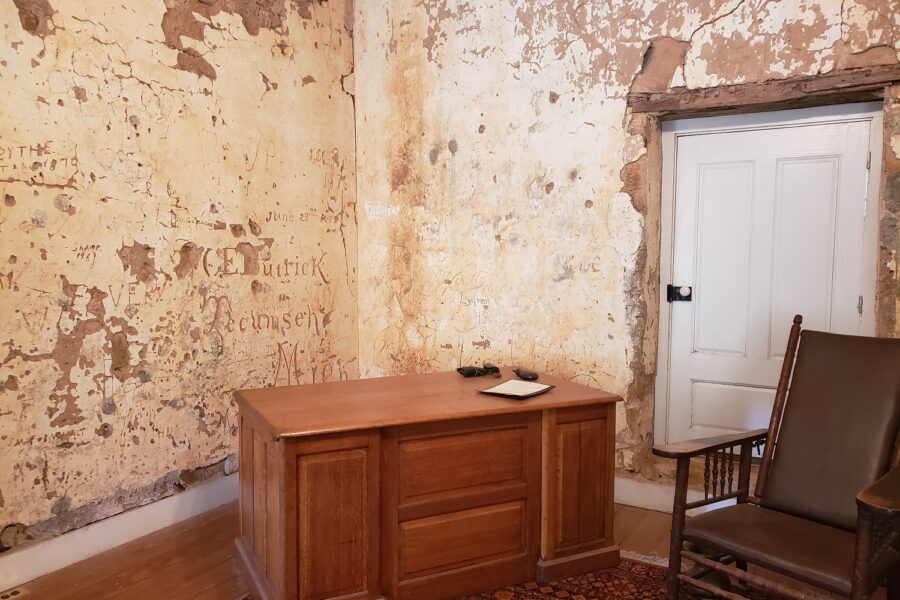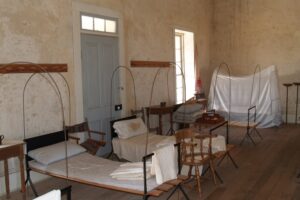Finding Fort Chadbourne
We leave the quaint village (a population of 308 should qualify as a village even if it is the County Seat) of Paint Rock in our dust, making our way through the town of Bronte and heading toward our ultimate destination — Fort Chadbourne. Of course, even with Google Maps in my hand showing me what to do, my interpretation causes us to shoot past our exit and make a few wrong turns. But as always, Michael’s geographic directional nose is much better than mine; he soon lands us in front of the Visitor Center.


I know there is an old fort here somewhere, but I don’t see it. And even though Fort Chadbourne’s website is informative, I was too rushed to delve into its depths past the Home Page. I only noticed that today was the first day they are open in a while due to vacations. This proclamation was strange to me and unexpected. I am half ready for a tourist trap.
A Professional Introduction
Walking into the spacious Visitor Center, after Michael pays our reasonable suggested donation of $10 each, we are immediately ushered into a small theater where we sit and watch an informative video. I am more than impressed by what I see; this is no half-baked, amateur production. What we observe and hear is professionally filmed. Educational. It tells me from soup to nuts the history of Fort Chadbourne, established in the Autumn of 1852, decommissioned in 1873, and resurrected — a dream reborn — in 1999.



I’m always fascinated by who and why which takes me to the beginning of the end of this story.
The Maverick’s and The Odom’s
We are here today because of a man named Thomas Odom, who purchased 320 acres of land from Mary Maverick, the widow of Samuel Maverick, for $500 in gold in 1877.


Side Tracking
So now I must sidetrack because I am having a déjà vu moment via Michael’s ancestor Matthew Caldwell, a signer of the Texas Declaration of Independence. Matthew took refuge in young Mary Maverick’s house in San Antonio after being wounded during the Council House Fight in 1840. A friend of ours in Wimberley, Joe Maverick, is a descendant of Mary Maverick. I feel like I know her. Connections. They are everywhere!
Samuel Maverick
Even though Samuel Maverick was a land baron, as well as a lawyer, politician, surveyor, and signer of the Texas Declaration of Independence, I can’t help but wonder how he came to own a fort. I discover the answer! Before Fort Chadbourne was first established, and in anticipation of the location of a fort in this spot, Maverick purchased the land where Fort Chadbourne stands today, leasing, not selling it to the US Military. I wonder…
Being a surveyor, he (Samuel Maverick) had access to land records and, if the land was of particular interest he would buy the property. His endeavors helped him acquire land which housed Fort Clark, Fort Mason and Fort Chadbourne.
(Marks, The Handbook of Texas Online)
Thomas Odom
When Odom purchased the acreage (the first of eight generations to live on this land), he planned on utilizing some of the buildings of Fort Chadbourne for his ranching operation. He moved his family into the dual officer’s quarters, a dog trot-style residence, also using it as his headquarters. With each succeeding generation acquiring more land, the OD Ranch, now the Chadbourne Ranch, at one time stretched almost to San Angelo, comprising 150,000 acres.
Enter Garland Richards
Generations later, a young boy — Garland Richards — spent his days exploring the shambles of what was left of the old Fort that was literally part of his backyard. At the time, he didn’t think it was anything special to have historic ruins to explore and assumed that EVERYONE possessed their own version of a Texas fort. Richards grew older and realized the value of what stood in his backyard. He didn’t want to see it fade into a footnote in history — he wanted to share it with the world.




Richards financed the entire restoration project without government funding, even though he was told doing it without this type of aid would be virtually impossible. Undaunted, Richards established the Fort Chadbourne Foundation in 1999, and with the help of friends, volunteers, and financial supporters, he got to work. Garland Richards and his wife Lana opened the Fort’s doors to the world less than ten years later with various projects still to be completed.
I guess you should never tell a Texan that something is impossible.
A Tour
The Fort lies beyond the room where we sit — and I can’t wait to see it.
There are only the two of us watching the film, and once it ends, we are ushered out the door and join a group of three others for our guided tour of the buildings. We take our place on one of the Fort Chadbourne Foundation’s eight-passenger tourmobiles. (Is that what you would call it? I have no idea.) Our guide, Brent, takes the wheel of the bright orange Kubota that is, apparently, the little engine that can and hauls us away up the gently sloping hill.


Fort Chadbourne Reconstruction – A Labor of Love
Now I must confess, I am not thrilled to be carted around and given a tour by rote. Been there, done that. So, I am a bit apprehensive about what is in store. Then we stop, and Brent begins to speak. He talks not in memorized lines from a script but uses words from his heart and his experience. In his quiet, unassuming West Texas voice, telling us that he was here from the beginning — helping to rebuild the Fort. Brent and a handful of individuals put Humpty-Dumpty back together again under the supervision of Larry Riemenschneider, Steward with the Texas Historical Commission. Some of the buildings even had to be reconstructed from the ground up. It must have been a daunting task.

Stepping into one of the old Fort’s structures, I understand why the Foundation does not want individuals wandering at will. Odom/Richards’ family heirlooms are in the officers’ quarters.
In another building the roof fell in decades ago and the effects of constant exposure to the elements caused plaster to peel from the walls, uncovering the original plaster. The layer underneath was filled with graffiti left from those who once walked these hills in the 1800s. The walls look as fragile as old parchment.
We continue our meandering and exploration, even learning about Texas quail.



Established in 1852 to protect the western frontier and the Butterfield Overland Mail route, Fort Chadbourne was decommissioned due to the lack of natural resources, mainly water. So, the soldiers moved on and built Fort Concho in San Angelo, close to the Concho River. They did try drilling for water at Fort Chadbourne way back when, but they didn’t drill deep enough, stopping six feet shy of hitting water.
Butterfield State Station
Our final stop on this tour is the reconstructed Butterfield Stage Station. Walking in here, listening to Brent, and reading the storyboards, is a true education on what life and travel were like more than 150 years ago. I am so grateful to have the conveniences of the 21st Century at my fingertips.
I should have known, but I guess I don’t watch enough western movies to realize that some stagecoaches carried mail, not just passengers. And I sure didn’t realize the passengers were packed inside like sardines. There are two rows of seats facing each other and one row in the middle of the stagecoach before me. Each seat holds three individuals — and the mail!

Nine passengers on the Butterfield Stage Coach traveled day and night from Saint Louis to Fort Chadbourne and Fort Chadbourne to San Francisco. It was a continuous ride of too many hours with only two breaks a day of about 40 minutes. I probably would have stayed at home.
A large sign has snippets from various passengers about the cross-country journey; one quote that I read sums up the experience pretty succinctly.
“Had I not just come out of the route, I would be perfectly willing to go back. But now I know what Hell is like. I’ve had 24 days of it.”


Fort Chadbourne – The Museum
By the time we finish looking around, reading, and inspecting, my head is reeling. But when we walk into the museum, I am on sensory overload. I realize now that we didn’t allow enough time to experience this Fort. The exhibits cover artifacts from Native Americans, the Military, and Ranching. There are more arrowheads and guns and memorabilia of life in West Texas than I have ever seen; about a million artifacts have been found on the Fort Chadbourne property. All of them are here – all of them cataloged.
Because the Fort has been on private property since being decommissioned, this site is the most pristine, unmolested, historically significant site of any of the frontier forts in the United States. That is impressive.




Garland Richards’ dream of rebirth born from tumbled-down ruins has come to fruition. This old Fort is a must-see piece of history. If you love Texas. If you love Texas history, take any road you see leading to Fort Chadbourne.
You will be blown away at what you discover.
Fort Chadbourne Information
| Location: 651 Fort Chadbourne, Bronte, Texas 76933 – Fort Chadbourne is located midway between Abilene and San Angelo, Texas on U. S. Highway 277, 12 miles north of Bronte. Hours: Tuesday thru Saturday from 8:00 a.m. until 5:00 p.m. Closed most major holidays. Admission: Admission is free but a $10.00 donation per person is appreciated Phone: 325-743-2555 or 325-743-2556 Website: https://fortchadbourne.org/index.html |
For more information on Fort Chadbourne, its history, and reconstruction, visit the following website:







Leave a Reply
Your email is safe with us.